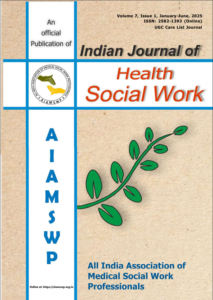Indian Journal of Health Social Work
(UGC Care List Journal)
A Study on the Prevalence of Anemia amongst the Children Residing in the Urban Slums of Kolkata
Panchali Dasgupta1, & Moumee Jesmin2
1 Consultant Nutritionist, All India Institute of Hygiene and Public Health, Bidhannagar, Kolkata. West Bengal, 2 Development Practitioner, EHSAAS- Feel the Desire of Nature and Society, Mithani, Asansol, West Bengal
Correspondence: Moumee Jesmin, e-mail: swjesmin95@gmail.com/p>
ABSTRACT
Background: Anaemia is a condition of having a low number of red blood cells to carry adequate oxygen to the body’s tissues. Iron deficiency anaemia and vitamin deficiency anaemia are very common among children. According to WHO data, in 2019, global anaemia prevalence was 39.8% (95% UI 36.0%, 43.8%) in children aged 6–59 months, equivalent to 269 million children with anaemia. Those children who live in slum areas are prone to being malnourished in terms of height, weight, haemoglobin and other micronutrient deficiencies because of social and health disadvantages that are associated with extreme poverty, unhygienic practices, lack of knowledge and education etc. Aim: The aim of this study is to know the prevalence of anaemia amongst the children residing in the urban slums of Kolkata. Methods & Materials: The study follows a quantitative research approach and was conducted in a few urban slums of Kolkata, West Bengal. Simple Random Sampling is being used to reach the respondents. The data was collected using a survey questionnaire developed by a team of nutrition specialists of Hola Nutriment. Results: In the study sample of 1000 children, 56.7% are male and 43.3% are female. Among them, 60.6 % of males are anaemic and 77.59% of females are anaemic. Conclusion: The findings of the study have shown that there is an association between low-birth weight and anaemia. The number of antenatal check-ups is also correlated with anaemia and low birth weight.
Keywords: Children, Anaemia, Low-Birth Weight, Urban Slums, Kolkata.

ISSN: 2582-1393 (online)
UGC Care List Journal

